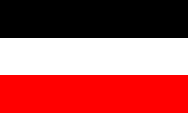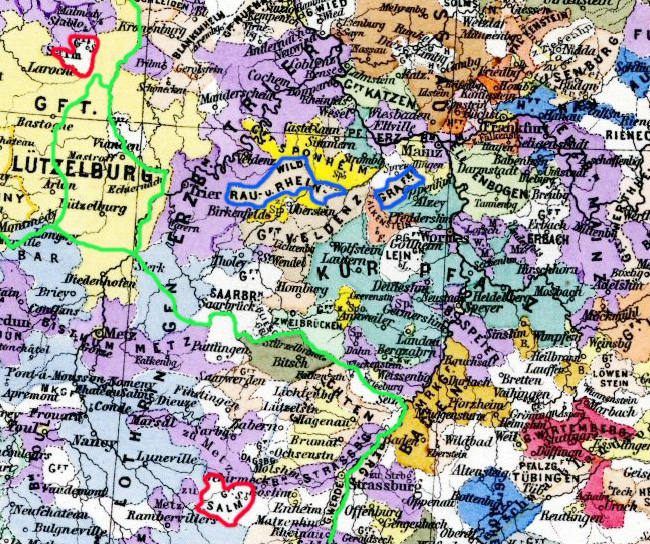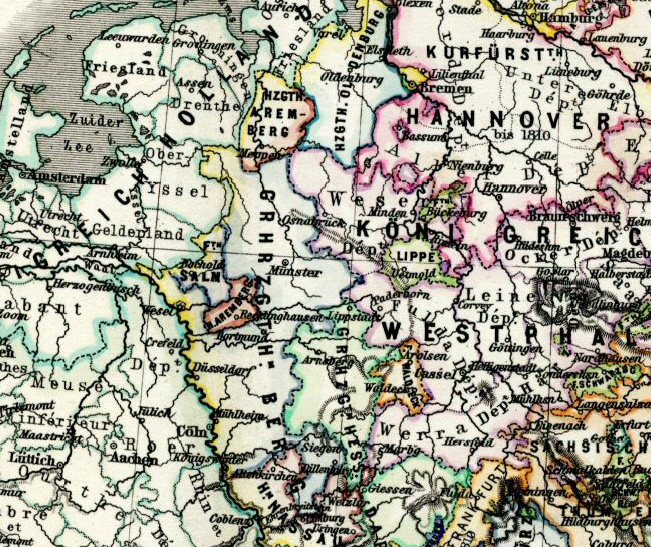mobile View, to the German Version tap the flag


- Principality of Salm
- 1803–1811 existend state
- Member of the Rhine Confederation
- even: Salm-Salm and Salm-Kyrburg
• Flag
• Meaning/Origin of the Flag
• Coat of Arms
• Meaning/Origin of the Coat of Arms
• Map
• Numbers and Facts
• History
• Origin of the Country's Name

1803–1811,
Flag of the country,
ratio = 3:5,
Source, by:
Wikipedia (D)




The flag showed three horizontal stripes in black, white and red. It is a combination of the colours of the Rhine Counts (black and white) with the colours of Salm (red and white). The lineage of Upper Salm extinguished in 1475, and the county passed as a legacy to the "Wild and Rhine Counts", who called themselves since them Counts (later Princes) of Salm. All the lines of this house used this flag (Salm-Salm, Salm-Salm and Kyrburg Horstmar).
Source: Volker Preuß,
World Statesmen


Salm, to 1163

Lower Salm (Niedersalm), to 1416

Upper Salm (Obersalm), to 1475

Lower Salm (Niedersalm), from 1416

Salm-Reifferscheid

"Wild and Rhine Counts" (Wild- und Rheingrafen)

Salm-Salm

Salm-Kyrburg
Source, by: Wikipedia (D)

The coat of arms of the County of Salm showed originally two silvery salmons, on a red shield, sprinkled with silvery crosses. At the division of the county Upper Salm retained this coat of arms at, for Lower Salm the colors became reversed and left out the crosses. When the lineage of Lower Dalm died out in 1416, the coat of arms was combined with the heraldry of the heirs from the family Reifferscheidt-Dyck. The families and family-branches of Salm-Reifferscheidt had its own coat of arms. These families are now all extincted, except Salm-Reifferscheidt-Raitz, now residing in Castle Steyreck. When the lineage of Upper Salm extincted in 1475, the county passed as a legacy to the "Wild and Rhine Counts", and these took to the heraldry of Upper Salm in the central-shield of their coat of arms, which varied a little bit from family to family-branch. Today there still exist the lineages of Salm-Salm and Salm-Horstmar. To the heraldry of the "Wild and Rhine Counts" are assigned different elements. The Rhine Counts used a silvery leopard on black, but also a silvery bar on blue. The Wild Counts counts used three golden lions on red, and from 1223 a red lion on gold. From the year 1409 both counties were united.
Source:
Volker Preuß


Source: Hand-Atlas für die Geschichte des Mittelalters und die neueren Zeit von Spruner und Menke,
modyfied by: Volker Preuß
The historical map shows Lower Salm in the northwest and Upper Salm in the south, both in red outline. The "Wild and Rhine County" is outlined in blue. The green lines mark the today's boundaries between Germany, France, Belgium and Luxembourg.

Source: Hand-Atlas für die Geschichte des Mittelalters und die neueren Zeit von Spruner und Menke
The historical map shows the Principality of Salm (1802–1811), in the west, within an blue coloured border.

Area: 658 square miles
Inhabitants: 59.000 (1810)
Capital: Bocholt
Currency: unknown
Source:
Wikipedia (D)

1036 · Giselbert, grandson of Wigerich, the Count Palatine of Lorraine, bears the titles of Count of Salm and Count of Luxembourg
1059 · death of Giselbert, the heritage goes to the sons, Konrad I, (Count of Luxembourg) and Hermann (Count of Salm)
1163 · Hermann's grandson Heinrich I. divides the county by inheritance in Upper Salm (placed in the Vosges) and Lower Salm (placed in the Ardennes)
1416 · extinction of the lineage of Lower Salm, the legacy goes to the Lords of Reifferscheidt and Dyck
1460 · Johann VI. of Reifferscheid, bears officially the title Count of Salm, foundation of the lineage of Salm-Reifferscheid
1475 · extinction of the lineage of Upper Salm, the inheritance goes to the "Wild and Rhine Counts of Dhaun and Kyrburg", who now called themselves Counts of Salm, 1623 they became imperial princes, and extincted in 1738
1645 · the Princes of Salm acquire the Dominion of Anholt near Bocholt in the Diocese of Muenster
1674 · birth of Heinrich of Salm (1674-1714), emergence of the lineage of Salm-Kyrburg
1701 · emergence of the lineage of Salm-Salm, first Prince is Nicolaus Leopold (1701–1770)
1793 · annexation of the principality of Salm-Salm (Upper Salm) by France
1794 · annexation of the territories and estates of the Princes of Salm-Kyrburg by France
1799 · birth of Friedrich Wilhelm of Salm (1799–1826), emergence of the lineage of Salm-Horstmar
1792, 1796, 1800 and 1805 · invasions of French revolutionary troops under Napoleon in the German Empire, the German Empire subjectes and becomes territorially transformed
1801 · all left-bank territories of the River Rhine ceded to France, and incorporated by this (in this way the in the Ardennes placed Lower Salm)
1803 · German Mediatisation (Reichsdeputationshauptschluss), transformation of the territorial partition of the German Empire, ecclesiastical possessions become confiscated, old princely territories and free cities become confiscated or dissolved or annexed to old or new principalities, the number of sovereign authorities and territorial entities of the empire is thus reduced from 300 to 60 – the Princes of Salm-Salm and Salm-Kyrburg become compensated with lands of the former Diocese of Muenster around the City of Bocholt, establish of the Principality of Salm as a condominium of the Principalities of Salm-Salm and Salm-Kyrburg (States of the Princes of Salm)
12th of July in 1806 · Napoleon forces the creation of the Rhine Confederation, an alliance of sixteen southern and southwestern German states under French protectorate, the Principality of Salm is one of the founding members
1st of August 1806 · the states of the Rhine Confederation declare themselves sovereign and resign from the Holy Roman Empire of German Nation
6th of August in 1806 · Emperor Franz II. lays down the crown of the Holy Roman Empire of German Nation, the empire ends
13th of December 1810 · the principality of Salm is annexed by France
October 1813 · Napoleon's defeat at Leipzig, the Confederation of the Rhine begins to fall apart, Napoleon and his troops withdraw behind the Rhine River
2nd of April in 1814 · Napoleón is deposed as emperor of France and exiled to Elba
1814–1815 · Congress of Vienna, reconstruction of Europe after the era of Napoleon, the ownership and the administrative partitions in the former German Empire become restored, but not the sovereignty of the ecclesiastical countries, and even not Principality of Salm, their possessions become transferred to old or new principalities, the territories of the Principality of Salm come to Prussia, the 39 remaining German states become organized in a loose association, the German Confederation
1905 · death of Prince Friedrich VI. of Salm-Kyrburg, the lineage extincts
Source: Wikipedia (D),
World Statesmen,
Royalty Guide

The name "Salm" goes back to a Castle of Salm near the River Salm in the Vosges. Salm means "Salmon". There were probably many of these fishes in the mentioned river.
Source: Wikipedia (D)







![]()














